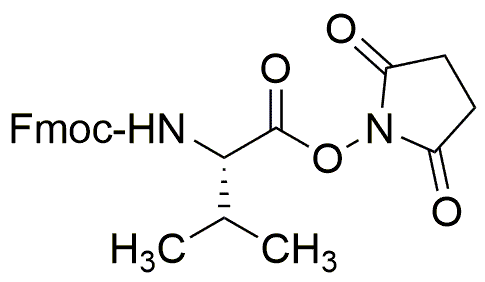Fmoc-L-valine N-hydroxysuccinimide ester is widely utilized in research focused on:
- Peptide Synthesis: This compound serves as a key building block in the solid-phase synthesis of peptides, allowing for the efficient coupling of amino acids and enhancing the purity of the final product.
- Drug Development: It is used in the creation of peptide-based pharmaceuticals, where its stability and reactivity facilitate the design of novel therapeutic agents.
- Bioconjugation: The compound is instrumental in bioconjugation techniques, enabling the attachment of peptides to various biomolecules, which is crucial for developing targeted drug delivery systems.
- Research in Proteomics: It aids in the study of protein interactions and functions, providing researchers with tools to modify proteins for better analysis and understanding of biological processes.
- Diagnostics: This chemical plays a role in the development of diagnostic assays, where it can be used to label peptides for enhanced detection and quantification in various biological samples.
General Information
Properties
Safety and Regulations
Applications
Fmoc-L-valine N-hydroxysuccinimide ester is widely utilized in research focused on:
- Peptide Synthesis: This compound serves as a key building block in the solid-phase synthesis of peptides, allowing for the efficient coupling of amino acids and enhancing the purity of the final product.
- Drug Development: It is used in the creation of peptide-based pharmaceuticals, where its stability and reactivity facilitate the design of novel therapeutic agents.
- Bioconjugation: The compound is instrumental in bioconjugation techniques, enabling the attachment of peptides to various biomolecules, which is crucial for developing targeted drug delivery systems.
- Research in Proteomics: It aids in the study of protein interactions and functions, providing researchers with tools to modify proteins for better analysis and understanding of biological processes.
- Diagnostics: This chemical plays a role in the development of diagnostic assays, where it can be used to label peptides for enhanced detection and quantification in various biological samples.
Documents
Safety Data Sheets (SDS)
The SDS provides comprehensive safety information on handling, storage, and disposal of the product.
Product Specification (PS)
The PS provides a comprehensive breakdown of the product’s properties, including chemical composition, physical state, purity, and storage requirements. It also details acceptable quality ranges and the product's intended applications.
Certificates of Analysis (COA)
Search for Certificates of Analysis (COA) by entering the products Lot Number. Lot and Batch Numbers can be found on a product’s label following the words ‘Lot’ or ‘Batch’.
Numéro de catalogue
Numéro de lot/série
Certificates Of Origin (COO)
This COO confirms the country where the product was manufactured, and also details the materials and components used in it and whether it is derived from natural, synthetic, or other specific sources. This certificate may be required for customs, trade, and regulatory compliance.
Numéro de catalogue
Numéro de lot/série
Safety Data Sheets (SDS)
The SDS provides comprehensive safety information on handling, storage, and disposal of the product.
DownloadProduct Specification (PS)
The PS provides a comprehensive breakdown of the product’s properties, including chemical composition, physical state, purity, and storage requirements. It also details acceptable quality ranges and the product's intended applications.
DownloadCertificates of Analysis (COA)
Search for Certificates of Analysis (COA) by entering the products Lot Number. Lot and Batch Numbers can be found on a product’s label following the words ‘Lot’ or ‘Batch’.
Numéro de catalogue
Numéro de lot/série
Certificates Of Origin (COO)
This COO confirms the country where the product was manufactured, and also details the materials and components used in it and whether it is derived from natural, synthetic, or other specific sources. This certificate may be required for customs, trade, and regulatory compliance.


